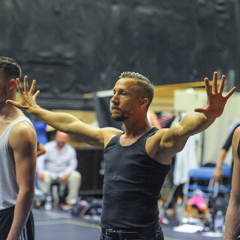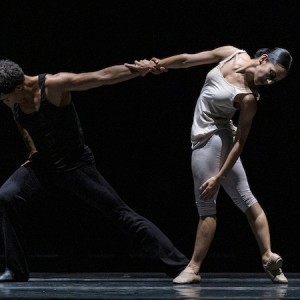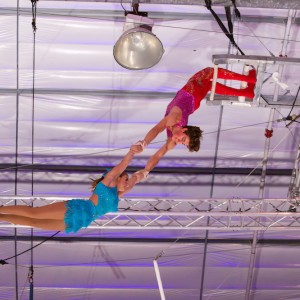Entering the fourth and final season of the American Character Project, which began with 1776 and continued through Show Boatand South Pacific with each exploring the country’s history of racial divide and slow growth, Asolo Repertory Theatre opens with a production of the Tony Award-winning classic West Side Story. “The most recent immigrant group fighting against by the ones right before them seems to be a recurring American story,” says Asolo artistic director Michael Donald Edwards. “There is an emotional and thematic connection between all these works, but each represents a unique expression of the American Sound.”

Bringing acclaimed choreographer and West Side heir-apparent Joey McKneely to Sarasota as director and director of choreography was integral to the production. “If there’s a person in the world who’s been designated as the choreographer for West Side Story, it’s him,” says Edwards. “He’s the reason I wanted to do it.”
Great things were apparent from McKneely given his meteoric rise in the world of theater. A self-described “disco baby,” McKneely went from an amateur enthusiast to stumbling into high school productions to traveling to Los Angeles on a dance scholarship in a few short years, receiving his first formal training at age 17 and landing a job on Broadway two years later with a production of Starlight Express. In 1988, choreographer Jerome Robbins chose McKneely for his 1989 retrospective Jerome Robbins’ Broadway, featuring work from throughout his storied career, including selections from Gypsy, Fiddler on the Roof and West Side Story.

A Tony Award-winning director and choreographer himself, Robbins carved a place for himself as a master of the craft, not least for his award-winning choreography in the original 1957 debut of West Side Story (also the debut of a little someone named Stephen Sondheim). At the time, McKneely admits, he wasn’t fully aware of the company he was about to keep. “I knew it was something big, a huge endeavor,” says McKneely, “but from my perspective, I was just happy to have a job and thrilled to be dancing.”
It didn’t take long for McKneely to understand where he was, however, and he describes that experience as a masterclass in choreography, not only informing him as an individual dancer but igniting an aspiring choreographer. “The most amazing thing about the essence of choreography is how it tells a story. I was never exposed to that before,” says McKneely. “Choreography can be more than ‘step to the left, step to the right.’ It can add character, emotion, plot, and encapsulate storytelling.”
“Sometimes choreography is like text,” adds Edwards. “The great choreographers are like writers and they create a world, a grammar and a language that is communicated through the body. Nothing is random, everything is considered.” It harkens back to the Greek theater of old, he says, when the presentation of a story was always a combination of music, dance, singing and acting. “The Greeks understood that,” he says.
“[Robbins’] choreography is absolutely captivating because it always has a truth to the character, and like any great theater work, it must have truth and honesty,” says McKneely. “He understood that. He understood human behavior and human nature and was able to translate that into movement.”
Case-in-point: The Snap. Most iconic for the stand-off between snapping and prowling street toughs, the snap permeates Robbins choreography like malleable punctuation. “That snap is a communicator,” says McKneely. “To me, that’s the essence of West Side Storyall in one gesture.”
But McKneely’s involvement with the Jets and the Sharks wouldn’t end with Robbins’ retrospective. Like the gangs on stage, McKneely was in for life. Roughly 10 years later, McKneely was tapped to direct a production of West Side Story at La Scala Opera House, using Robbins’ original choreography. Helming the entire production, McKneely grappled with Arthur Laurents’ text for the first time, understanding how the words informed the choreography and vice versa. Opening in Milan, McKneely’s world premiere garnered an Olivier Award nomination, toured through Paris and London and caught the attention of Laurents himself, the original librettist organizing a Broadway revival with a grittier feel. The 90-year-old Laurents would direct, but needed someone who could not only reproduce Robbins’ choreography but also update the iconic moves for a modern audience.
“It was very difficult,” says McKneely of the 2009 revival. “I was standing between two masters and trying to be true to both.” Laurents wanted to approach the production from more of a straight play perspective, as opposed to a musical, and bring forth the more hard-hitting aspects of the play that could possibly be overshadowed by the nicety and precision of the dance. In short, Laurents wanted him to tweak Robbins’ award-winning opus. McKneely describes the experience as both challenging and rewarding, “but I would never claim that I can improve Jerome Robbins’ choreography,” he says. “That’s like painting the Mona Lisa again and thinking you can put a smile on her.”
For the show at the Asolo, McKneely says he will be true to Robbins’ original choreography, making this the American premiere of his La Scala production, but admits there exists a challenge in bringing the show to modern audiences. “The look of it—the style, the presentation—looks dated,” he says, especially to the “put it all out there” generation, with a people more volatile and faster-paced, including himself, a self-professed member of the MTV Generation. He singles out the film Grease as a particular problem, cementing the image of The Greaser as a harmless archetype instead of a true character. “I’m a torchbearer bringing West Side Story to a new generation,” McKneely says. “I bring the classic, but I infuse it with youthful energy and a modern sense.”
So the kicks may be higher, the leaps a little more forceful, but Robbins’ iconic moves will remain. “In a way, the choreography is more timeless than the text,” says Edwards. Where Laurents may have been constrained in his vocabulary, substituting “Buddy Boy” and “Fuggin’” for words then disallowed on stage, Robbins faced only the constraints of his and the dancers’ talent. “All that energy that goes into language now, goes into the dancing.” He’s seen productions update the language, but found it more jarring than illuminating and decided against that route, trusting the power of Robbins’ choreography and McKneely’s direction.
“The themes are very modern,” says McKneely, unconcerned as to whether or not the community will connect to a story about immigration, assimilation, fear and racism. West Side Story speaks to those things, he says, and his challenge is to “make the audience feel the material, but not put it into a prism of the past.”
There may never be a point when West Side Story is not timely, McKneely says. “Maybe when we can all live together and get along,” he opines, “but I fear that’s not in the human nature. It’s in the human spirit, but not the nature.” Great theater, however, retains its ability to change the individual. “When you put hate into the world, souls are shattered and hearts are broken, and we need to be reminded of that.”
“We are not shying away from what the country’s going through right now and we’re saying maybe we can help,” says Edwards. “Our politics is so broken and degraded, maybe it’s time for the theater to step up.”










